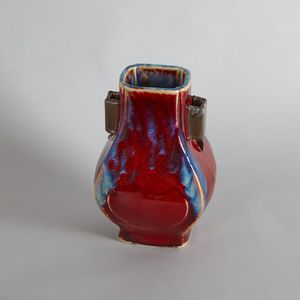Late Qing Dynasty Flambe Glazed Fanghu Vase
A Chinese late ___13E1EAf4-BCC1-4A45-527DD56E112B1A1A___ Dynasty flambe glazed Fanghu vase (Da Qing Qianlong Nian Zhi mark). A rare Chinese vase, known as fanghu or arrow vase, covered with a flambe glaze. The glaze has been trickled to a relatedly even line around the foot rim, consistent with red glazes of the 18th century. An incised Qianlong mark on the base, has been partially covered with a mustard coloured glaze, bearing labels for Musee Pince (French) and C.T. Loo. Also bears an incised mark translated as ware of Zhi Lan Shi. Condition: copper coated on handles, A/F. Note: in the later 19th century, the Empress, dowager Cixi reinstated fanghu vases as one of the prizes for the civil examinations.
You must be a subscriber, and be logged in to view price and dealer details.
Subscribe Now to view actual auction price for this item
When you subscribe, you have the option of setting the currency in which to display prices to $Au, $US, $NZ or Stg.
This item has been sold, and the description, image and price are for reference purposes only.
- Ming Dynasty - The Ming Dynasty was a ruling dynasty of China from 1368 to 1644. It succeeded the Yuan Dynasty and preceded the Qing Dynasty. The Ming Dynasty was established by Zhu Yuanzhang, a former Buddhist monk who became a rebel leader and eventually overthrew the Mongol Yuan Dynasty. During the Ming Dynasty, China experienced a period of relative stability and prosperity. The government was centralized and bureaucratic, with the emperor at the top of the hierarchy. The Ming Dynasty is known for its cultural achievements, including the development of porcelain, the invention of movable type printing, and the construction of the Great Wall of China.
- A/f, as Inspected - The letters "A/F" or "as inspected" as part of a description is the cataloguer's shorthand for "all faults" or "as found", meaning the item has some type of damage or deficiency, it is of uncertain date or provenance, and/or that the seller takes no responsibility for the completeness of the item or the accuracy of the description.
- Qing Dynasty - The Qing Dynasty was the last imperial dynasty of China, ruling from 1644 to 1912. It was established by the Manchu people, who originated from the northeastern region of China. The Qing Dynasty was preceded by the Ming Dynasty and followed by the Republic of China.
- Incised - A record of a name, date or inscription, or a decoration scratched into a surface, usually of a glass or ceramic item with a blunt instrument to make a coarse indentation. Compare with engraving where the surface is cut with a sharp instrument such as a metal needle or rotating tool to achieve a fine indentation.
This item has been included into following indexes:
- Chinese ceramics, dynasty mark or period - vases, Qianlong mark (1736-1795) 379
-
Chinese ceramics, item type
- vases, flambe glazed 82
- vases, other 2,540
